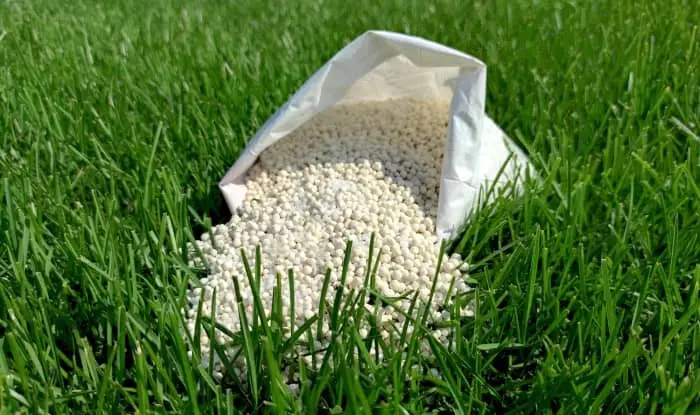Pre-emergent fertilizer combines pre-emergent herbicide with fertilizer in one easy-to-apply product. When you use it correctly, the pre-emergent herbicide prevents weed seeds from developing after germination.
The herbicide forms a protective barrier in the soil that inhibits root and shoot growth from the newly germinated seed. At the same time, the fertilizer provides essential nutrients for your grass, helping your lawn grow strong and healthy. This kind of product is also known as weed and feed.
How can you use it to get the best results? Read on.
When Should You Put Down Pre-emergent Fertilizer?
To prevent weed seeds from sprouting and developing into seedlings, you need to get the pre-emergent into the ground at the right time.
Ideally, this will be a couple of weeks before germination occurs in the spring. But at the latest, you want to make sure it’s at least 36 to 72 hours before germination.
The best time to apply pre-emergent herbicide is when the soil temperature reaches 55°F for several days in a row. You can keep track of this using a soil thermometer. Measure the temperature around 2 to 4 inches beneath the surface. In most areas of the United States, this will usually be sometime between late February and April.
If you identify the problematic weeds in your yard, you will be able to more accurately time your pre-emergent application and get better results.
How To Apply Pre-emergent Fertilizer
Apply the pre-emergent fertilizer to your lawn evenly. Make sure that no spots are left untouched. Depending on your product, you’ll find this easiest using a spreader or a weed sprayer. Make sure it’s well-calibrated. Then make slow and careful passes up and down the area.
Spot treatment is ineffective because weeds will grow in the untreated areas. And sections of the grass will be left unfertilized.
Also, take care to avoid too much overlap. Because if some areas receive too much fertilizer, it can burn the lawn.
Don’t Forget To Water
Whether your pre-emergent fertilizer is a liquid or granular, you need to water it into the soil. Watering activates the pre-emergent and helps it form a chemical barrier that prevents weed seeds from developing into seedlings.
How does it work?
When the roots and shoots first develop from the germinated seed, they contact the chemical pre-emergent barrier. The chemicals prevent cell division and the production of enzymes. This stops the development of the weed, killing it before it grows through the topsoil.
Once the chemical barrier is in place, make sure you don’t disturb the soil because this will reduce the effectiveness of the pre-emergent. Make sure not to aerate, till, dig, or slit seed.
Should You Mow Before Applying Pre-Emergent Fertilizer?
The pre-emergent fertilizer needs to get into the ground to be effective. So, mowing your lawn to a length of around 2-2.5 inches before applying the pre-emergent fertilizer will help more of the product soak into the soil after watering.
Use With Caution
Do you have a newly seeded lawn? Or a lawn that you plan to seed within the next few months?
If so, it’s best not to use a pre-emergent herbicide. Why?
Because it doesn’t only prevent weeds. It also inhibits grass seed from developing.
If you seed the area, wait at least 6 weeks before applying a pre-emergent herbicide. This gives time for the turf grass to become established. The pre-emergent herbicide won’t affect plants with established root systems, these will continue to grow.
You should also exercise caution while using the pre-emergent, taking care when handling and applying. Keep pets and children out of the area. And wait for the area to dry before allowing them back in.
Other Things To Consider
As convenient as pre-emergent fertilizer is, it might not be the best option for you to choose.
One of the potential problems when using pre-emergent fertilizer is timing. The best time for applying pre-emergent herbicide might not be the best time for lawn fertilizer.
The things you need to consider are:
- The type of turfgrass you’re growing
- Your location
- The type of weeds you’re trying to prevent
- The type of fertilizer you’re looking to add
Consider the recommended schedule for applying nitrogen fertilizer to your type of turfgrass in the area where you live. And see if that fits well with the best time for pre-emergent application.
Pre-emergent fertilizer containing a potassium fertilizer — for example, with an NPK ratio of 0-0-7 — is easier to use as part of a correct schedule for lawn care.
You Might Also Like:

